Medical And veterinary entomology midterm
1/207
There's no tags or description
Looks like no tags are added yet.
Name | Mastery | Learn | Test | Matching | Spaced |
|---|
No study sessions yet.
208 Terms
Entomology definition
The scientific study of insects, including their behavior, ecology, taxonomy, and physiology. Study of segmented arthropods.
Basic characteristics of Arthropods
Jointed appendages, segmented body, and External skeleton
Types of problems caused by arthropods
Annoyance/nuisance
Toxins and Venoms
• Toxins are chemicals that interfere with normal
physiological function
• Venoms are poisons injected by specialized
morphological structures
Disease: Destruction of host tissues
• Called “myiasis” when done by fly larvae
Disease = vector-borne diseases
Disease = Food contamination
Disease = Allergic reactions
Disease = Psychological stress
Fear
Delusional disorders (eg. Morgellons disease)
Class insecta
head louse, psocodea, diptera ( includes mosquitos, horse fly, and flesh fly), and Balttodea
Class Arachnida
includes scorpiones, trobidiformes, ixodida, and araneae
The most dangerous animal
Mosquitos (they kill 725,000 people a year). Malaria alone accounts for 600,000 deaths
Robert Koch
Koch’s postulates: germ theory of disease versus miasma theory
Patrick manson
Founder of the tropical medicine field. He discovered the role of mosquitoes in human elephantiasis.
Theobald smith
discovered the causative agent of texas cattle fever was vectored by the cattle tick
Ronald Ross
Described the life-cycle of the parasites of malaria
Walter Reed
Demonstrated the role of Aedes mosquitoes in the transmission of yellow fever.
William Burgdorfer, Alan Barbour, Jorge L Benach
discovery of the agent of lyme disease
Koch’s Postulates
Step 1: The microorganism must be found in abundance in all organisms suffering from the disease, but should not be found in healthy organisms.
Step 2: The microorganism must be isolated from a diseased organism and grown in pure culture
Step 3: The cultured microorganism should cause disease when introduced into healthy organism
Step 4: The microorganism must be reisolated from the inoculated diseased experimental host and identified as being identical to the original specific causative agent.
What is a vector borne disease
a disease transmitted by a vector
What is a vector
AN organism, typically a blood-feeding arthropod, that transmits a pathogen from an infected host to a naive host.
Modes of vector-transmission
Mechanical and Biological
Mechanical vector transmission
Picks up an infectious agent on the outside of its body and transmits it in a passive manner.
Biological vector transmission
propagative, cyclodevelopmental, and cyclopropagative
Propagative transmission
occurs when the organism ingested with the blood meal undergoes a simple multiplication in the vector
cyclodevelopmental transmission
the causal organism undergoes developmental changes from one stage to another but does not multiply in the vector.
Cyclopropagative transmission
The agent reproduces and undergoes cyclical changes in the vector
Four criteria used to identify a primary vector
associate and feed on the reservoir/s and its seasonality should coincide with the incidence of vertebrate infection
be commonly found infected with the disease agent in question (in "field" collections)
be shown to become infected experimentally
be shown to be capable of transmitting the disease to an uninfected host (under controlled conditions)
vector competence
refers to the ability of the arthropod to acquire, maintain, and transmit a pathogen.
Vectorial capacity
An equation that accounts for the major factors of pathogen transmission by mosquito’s and is defined as the average number of new vertebrate infections per day resulting from an initial index case.
Formula for vectorial capacity
The ratio of mosquitoes to humans ( m ); human biting rates ( a ); mosquito survival through one day ( p ); pathogen latent period (n days)

What 4 components does vectorial capacity depend on?
Number of mosquitoes divided by number of people, survivorship, feeding frequency and type, and vector competence
Bridge vector
Organism, typically a biting arthropod, that transmits a pathogen from one animal host to a human
enzootic vector
Organism, typically a biting arthropod, that transmits a pathogen from one animal host to another.
Risk probability of human infection
A = vector abundance, Fm = fraction of human blood meals, P = infection prevalence in the vector, Cv = fraction of infected mosquitoes that will transmit the disease by a subsequent bit = vector competence.
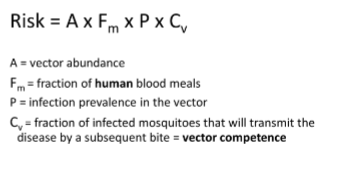
MIR
Mosquito infection rate is calculated as the ratio of the number of positive pools to the total number of mosquitos tested. ([Number of positive pools/Total specimens tested] X 1000)
Endemic disease
Refers to a disease regularly occurring in people within an area or community
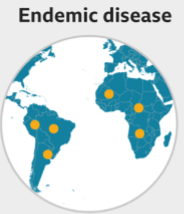
Epidemic
The rapid spread of disease to a large number of patients among a given population within an area in a short time
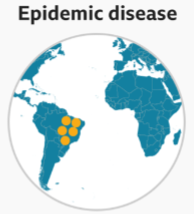
Pandemic
Is an epidemic of an infectious disease that has spread across a large region, for instance, multiple continents or worldwide, affecting a substantial number of individuals.
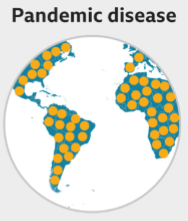
Enzootic
Refers to a disease involving non-human in a specific geographical area where the disease is constantly present at a low incidence. Basically the animal equivalent of endemic
Epizootic
Is the rapid spread of a disease to a large number of non-human patients among a given population within an area in a short time
Why are vector bone diseases on the rise
Global warming
Invasive mosquitos
They are the drivers of most recent epidemics of mosquito-borne diseases. invasive mosquitos are culex pipiens, culex quinquefasciatus, aedes albopictus, and aedes aegypti
Mosquito (culicidae) taxonomy
Kingdom: Animalia
Phylum: Arthropoda
Class: insecta
Order: Dipetra
Family: Culicidae
Subfamily: Anophelinae or Culicinae.
Morphological differences between anopheline and culicine in relation to the stages.
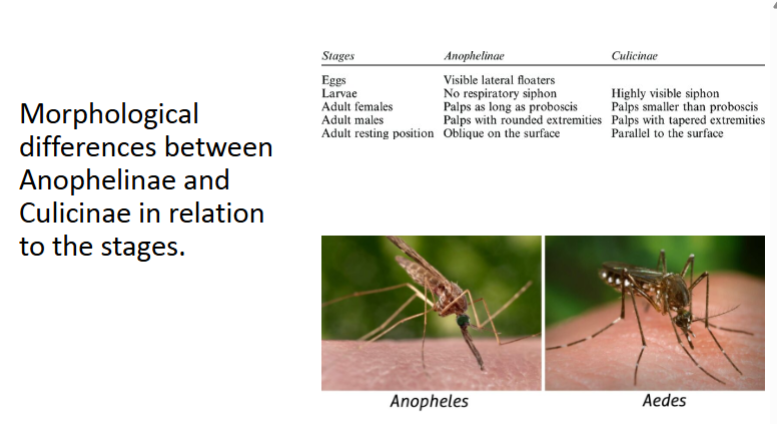
Anopheles gambiae complex (anthropophilic)
malaria and human filariasis. Contains A.gambiae (endophilic,endophagic) and A.arabiensis (drier climates).
Culex pipiens
Close group of domectis and peridomestic species. Can be vectors for west Nile, st.Louis encephalitis, and bird malaria).
found in temperate climates: cx. pipiens form molestus
tropical and subtropical: cx.Quinquefasciatus
Aedes spp.
vector for dengue, chikungunya, zika, and yellow fever.
Aedes aegypti (yellow fever mosquito). Feral form aegypti vs domestic aegypti
Aedes albopictus (asian tiger mosquito) cold hardy egg-diapausing strain is invasive.
Anthropophilic
Preferring or seeking a human host over another animal. supplement the term anthropophilic is used to describe parasites that prefer or seek human as host rather than other animals
endophilic
a mosquito that tends to inhabit/rest indoors
endophagic
a mosquito that feeds indoors
Mosquito eggs: Morphology
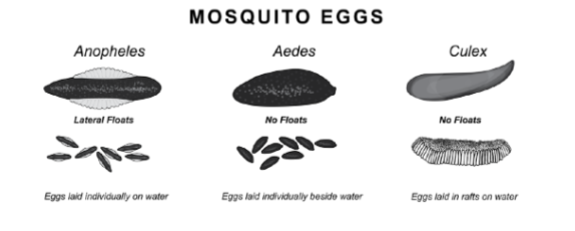
Larvae morphology
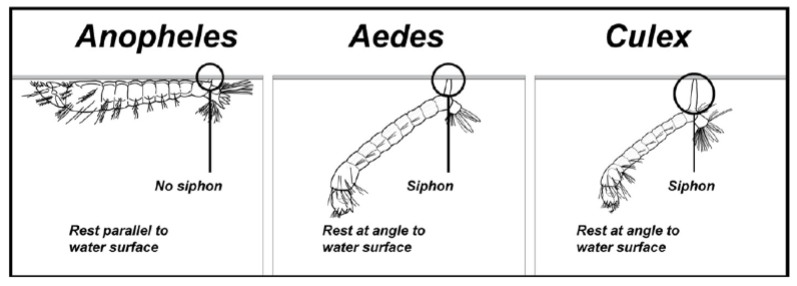
larvae morphology continued
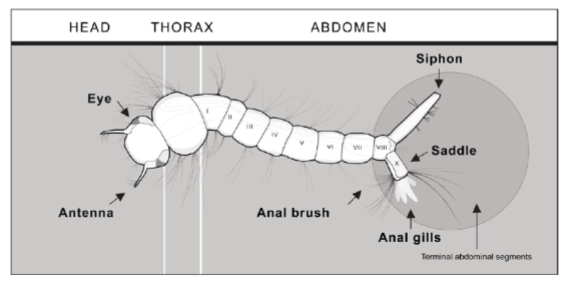
pupa morphology

Mosquito life cycle for culex
Eggs are laid in rafts at the water surface, larva rests at angle to water surface, pupa takes air from water surface, adult emerges at water surface from pupa
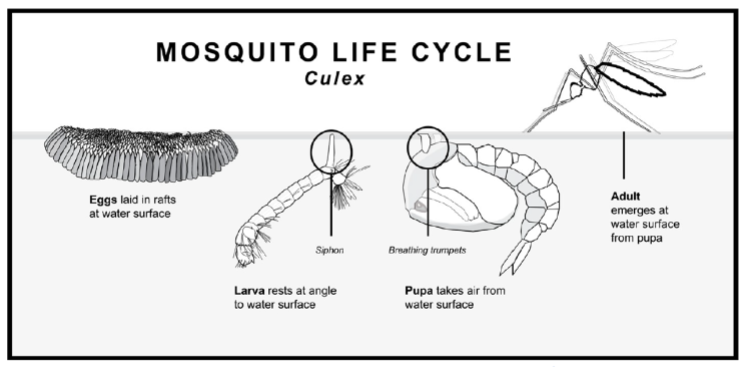
World wide invasive mosquitoes
Aedes aegypti (expanded worldwide after the 1500’s) (tropical)
Aedes albopictus (expanded worldwide after the 1960’s) (tropical and temperate)
Aedes japonicus japonicus (expanded worldwide after the 1990’s) (temperate)
US distribution of aedes aegypti L.
Alothough Ae.Aegypti is tropical it has permanent temperate populations
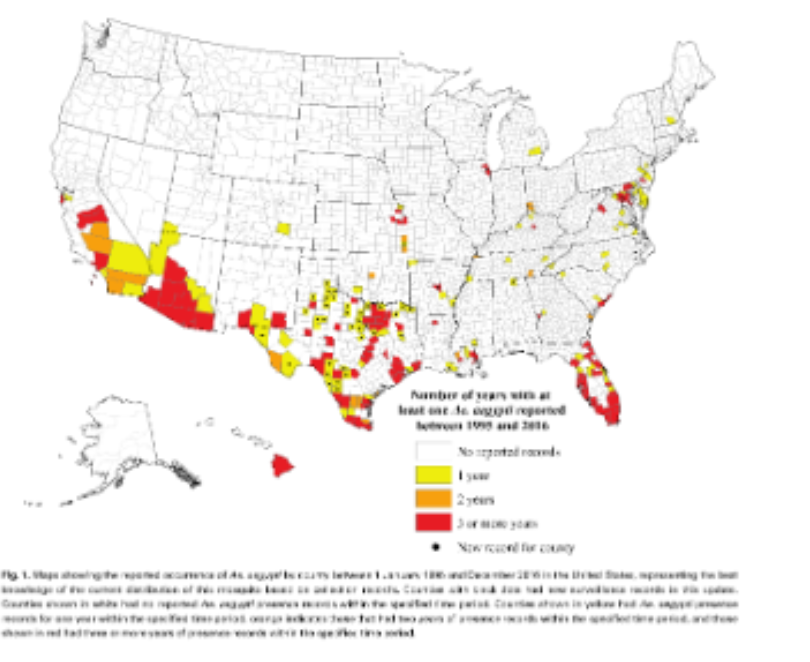
US distribution of aedes albopictus skuse
Aedes Albopictus has temperate and tropical forms. In its native range it occurs across a broad latitudinal range.
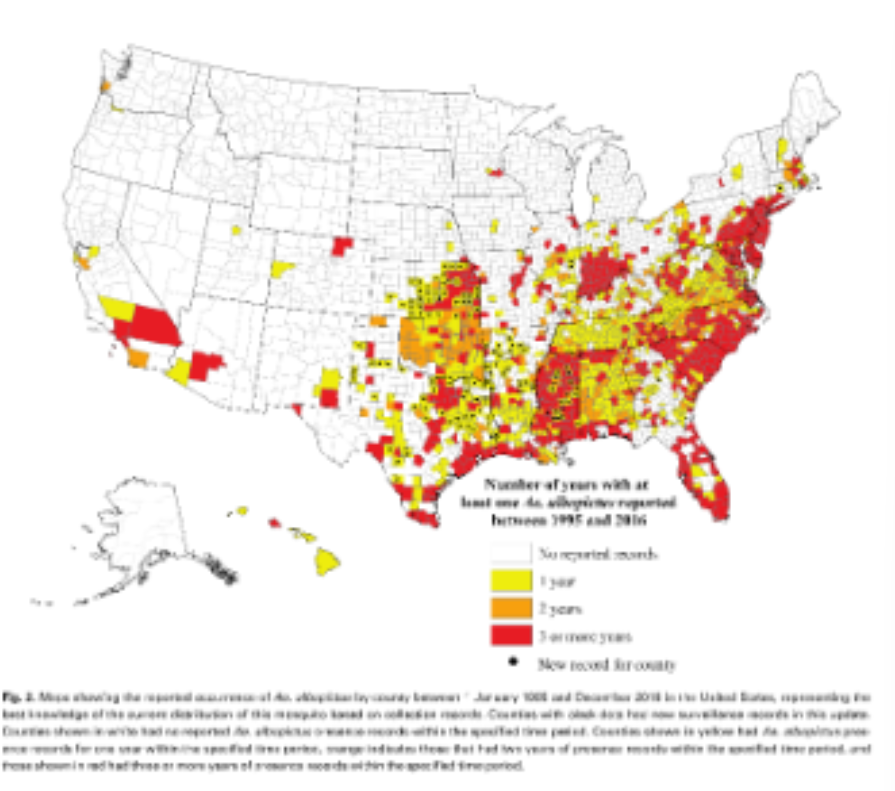
Phylum arthropoda
The largest in the animal kingdom.
Characteristics: exoskeleton (hardened plates with flexible joints) made predominantly of chitin (a nitrogenous polysaccharide = polymer of n-acetyl-glucosamine), articulated appendages, segmentation, open circulatory system (contains hemolymph and specialized excretory structures, malaphighian tubules).
Exoskeleton
AN exoskeleton is an external skeleton that supports and protects an animal’s body. It protects against predator, it supports and provides an attachment framework for muscles, and protects against desiccation.
encdysis
The molting of the cuticle in many invertebrates. repairs damaged tissue
cuticle
an inelastic exoskeleton. cuticle grows via fluids or air.
exuvia or exuviae
the empty exoskeleton
what happens to the cuticle after molting?
the cuticle is soft and it hardens and darkens following a tanning process.
epicuticle
thin and made of 4 layers: cuticulin layer, polyphenol layer (involved in tanning) layer, wax layer (essential for water retention) and cement layer (gland cells). p
procuticle
mix of protein and chitin (nitrogenous polysaccharide = polymer of n-acetyl-glucosamine).
what happens to the procuticle after molting
the procuticle differentiates into the endocuticle (soft and flexible) and exocuticle (hardness and rigidity/sclerotin)
Pore canals
cytoplasmic extension of epidermal cells that retract after molting form the canal
hemolymph
has the same functions of the vertebrate blood and lymph combined (except that oxygen reaches cells through the tracheal system - CO2 dissolves and is excreted by the malpighian tubes). Also acts as a physical force (hydraulic) to extend proboscis, reproductive organs, molt.
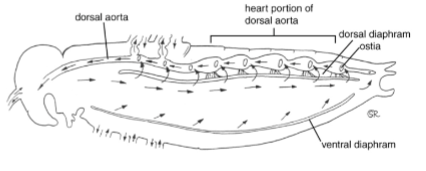
Hemocytes
cellular components that help with wound repair, detoxification, immunity
respiratory system
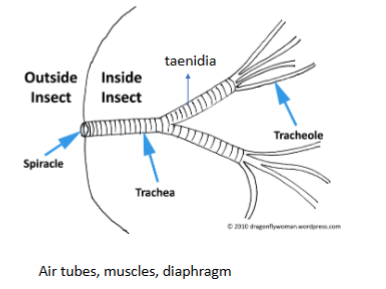
insect development
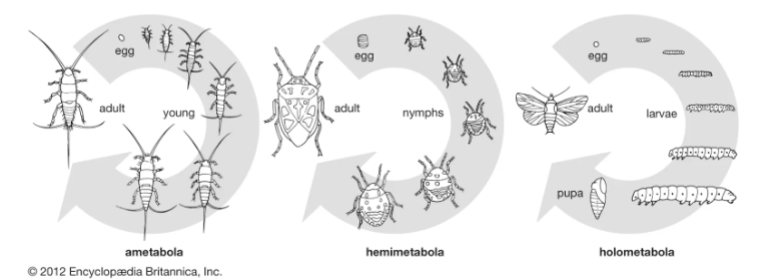
Ametabola
the most primitive wingless insects (apterygota), there is almost no change in form throughout growth to adult
Hemimetabolism or hemimetaboly
incomplete metamorphosis, is the mode of development of certain insects that includes three distinct stages: the egg, nymph, and the adult stage or imago. There is no pupal stage these insects only go through gradual changes. The nymph often has a thin exoskeleton and resembles the adult stage but lacks wings and functional reproductive organs
Holometabolous
prevents larvae from competing with adults because they inhabit different ecological niches. Each stage is adapted for different activities. Larval traits maximize feeding, growth, and development, while adult traits, enable dispersal, mating, and egg laying. Goes through complete metamorphosis.
Morphological adaptations of parasitic arthropods: body shape and wings
Modifications of body shape to facilitate movement on host. Ectoparasites with long-term close association with the host: dorsoventral (bedbugs, ticks) or lateral flattening of body (fleas). Wings (tabanids, lice, louse, flies)
Morphological adaptations of parasitic arthropods: Mouth parts
Adapted to feed on blood, hemolymph, skin secretions (mouth part adapted for piercing) or skin, feathers, skin scales (chewing mouth parts). Telemophages (pool feeders (create a pool of blood and then feed)) versus selenophages (capillary feeders (feed directly from the capillary)).
Mouth parts of insects
Chewing mouth part is the most archaic and every other one evolved from chewing mouth part
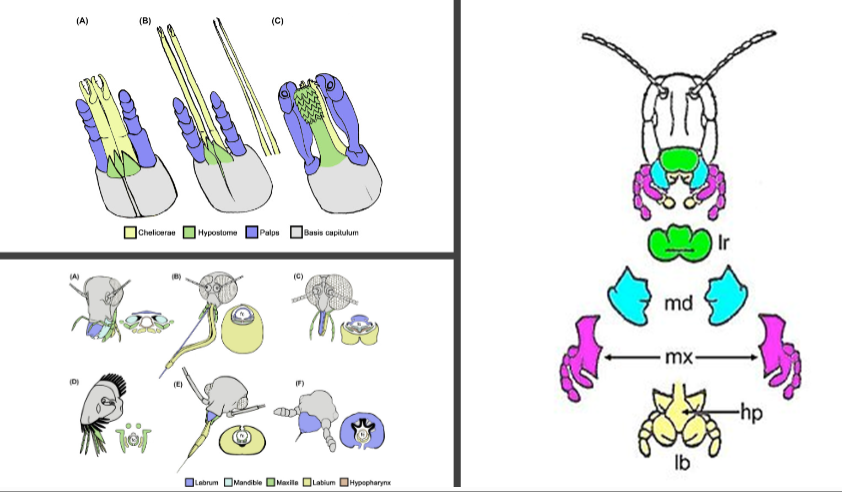
myasis
It is the parasitic infestation of the body of a live animal by fly larvae (maggots) that grow inside the host while feeding on its tissue.
WHat flies cause myasis
Calliphoridae (blow flies) and muscidae (house flies, stable flies).
How myasis occurs
flies are attracted to open wounds and urine or feces soaked fur. Some species (the botfly, blowfly, and screwfly) can create an infestation on unbroken skin. Myasis is vector mediated.
Free living flies
pseudomyiasis or accidental myiasis
Parasitic flies
obligatory myasis
pseudomyiasis or accidental myiasis
It is caused by free-living flies that can become parasitic under rare conditions. Ex. ingestion of food contaminated with eggs or larvae.
Facultative myiasis
Involves larvae that can be either free-living, detritivores or parasites. These flies are opportunistic.
{
Primary myiasis (facultative myiasis)
involve those species that can initiate myiasis
Secondary myiasis (facultative myiasis)
involves species that cannot initiate but can continue myiasis
Treitary myiasis (facultative myiasis)
species that join primary and secondary species at or right before host death
Obligatory myiasis
The maggots of the fly species involved in obligatory myiasis are always parasitic. they require a living host for their development
Temporary Myiasis (obligatory myiasis)
Intermittent contact between a fly larva and its host. Ex nestling maggots and floor maggots
incidental myiasis (obligatory myiasis)
parasitism of an atypical host by obligate myiasis producing flies.
Why do myiasis
It is a mean of exploiting a rich protein source by the larva for its development and in some cases for adult reproduction. Dietary proteins are required for growth, development, and egg production. Proteins can be obtained by larvae, adults or both.
Public health concerns of myiasis
Human myiasis is relatively uncommon. it occurs seasonally and sporadically in temperate regions and during the wet
season in the tropics.
In South America several hundred human cases by the New World screwworm (Cochliomyia hominivorax) have been reported.
Some Africans countries show a high prevalence of furuncular myiasis by Cordylobia anthropophaga
Most human cases of facultative or obligatory myiasis are only temporary or are aborted because humans are not suitable hosts.
Maggots do not complete their development in people because they are usually interrupted by self-grooming or medical intervention.
Types of myiasis in humans
Gastrointestinal myiasis, wound myiasis, and ophthalmic myiasis.
Gastrointestinal myiasis
ingestion of eggs or maggots from infested food can result in general malaise, nausea, vomiting, cramps and diarrhea
wound myiasis
people living close to farms and especially infirm people, are at higher risk.
Ophthalmic myiasis
the most common form of human myiasis. it is generally caused by a sheep nose bot when a gravid female oviposits into an eye while hovering.
Veterinary importance of myiasis.
Myiasis fundamentally affects wild and domestic animals.
• Exposure
• Untreated open wounds
Seasonal incidence: calving, foaling, lambing.
• Decrease humoral response against maggots.
• Placenta carrion and exposed umbilical cord enhance fly activity.
Economic impact
• Screwworms: commonly cause death.
• Carrion/blow flies (Calliphoridae)
• Flesh flies. (Sarcophagidae)
Screw worm myiasis (Cochliomyia homnivorax)
Diptera, Calliphoridae = blowflies or bottle flies
Affects warm-blooded animals and eat healthy tissue.
Infestation is serious and can be fatal.
It is present in the New World tropics.
There are five species of Cochliomyia
• C. macellaria= secondary screwworm (feed on necrotic tissue)
• C. homnivorax=primary screwworm (feed on healthy tissue)
• There is also a single Old World species in a different genus (Chrysomya bezziana)
Life cycle of Cochliomyia homnivorax
Gravid females are attracted to fresh open wounds on any warm - bodied animal
each female deposits 100-200 eggs (up to 1,000 in lifetime)
females feed at the wound to obtain extra protein/lipids
after 10-20 hours eggs hatch
maggots develop in 4-12 days, then drop to the ground and pupate
after 1 week adults hatch, mate. and in a few days, look for hosts
entire cycle (egg to egg) takes 2-3 weeks
Myiasis –Dermatobia homini (tórsalo, human bot fly)
they are from the order diptera and the family oestridae
the human botfly, dermatobia hominis is one of several species of flies, the larvae of which parasitise humans.
distribution: neotropical
pests of cattle, but also infects humans, dogs, monkeys
uses zoophilic or anthropophilic insects as porters: dermatoid fly eggs have been shown to be vectored by over 40 species of mosquitos and muscoid flies. The female captures the mosquito and attaches its eggs to its body.
Development: the larvae develop inside the subcutaneous layers. After about 8 weeks, they drop out to pupate for at least a week, typically in the soil. 3 larval instars: 5-10 weeks but may take 3 or more months (can overwinter). Pupae: 25 to 132 days (can overwinter)
the adults are large flies resembling bumblebees. they are easily recognized because they lack mouthparts.
larvae develops only if the wound does not become infected, patients rarely experience infections.
prevention and control of myiasis
Avoid contact between host and myiasis causing flies
early treatment of wounds to prevent myiasis
reduction or elimination of myiasis fly populations
Screwworm eradication program
The sterile male technique was developed and championed by screwworm researchers.
1945-1955 the first successful field test was achieved with the eradication of the primary screwworm C. homnivorax.
subsequent eradications were achieved in the USA, puerto rico, mexico etc.
Distribution and eradication of the screwworm fly
Currently, there is a sterile-male buffer zone at the Darien Gap between Panama and Colombia But there have also been reintroductions!
Sterile insect technique
SIT is a method of insect control whereby overwhelming numbers of sterile males are released into the wild. The sterile males compete with the wild males to mate with females. females that mate with a sterile male produce no offspring, thus reducing the next generation’s population. SIT is not self replicating and therefore cannot become established in the environment.